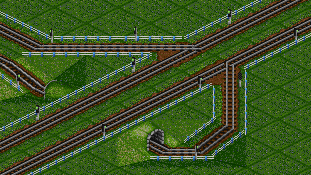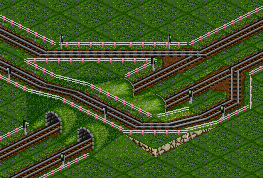-
Basic 3-Way
-
Line Merge
-
Half Cloverleaf
-
Half Spaghetti
-
Compact 3-Way
-
Compact 3-Way B-M Junction
-
Ultimate 3-way
-
Half Transmogrified
-
Braided Junction
-
Basic 4-Way
-
Roundabout
-
Cloverleaf
-
Spaghetti
-
Star
-
Complex Star
-
Branch-Merge
-
Tetrathorp
-
High Speed 4-Way Fly-over∕under
-
Pre-Signaled Roundabout
-
Advanced Roundabout
-
Right-of-way Roundabout
-
Improved Roundabout
-
Transmogrified
-
Tightlong
-
Deepblue2k8 4-way Junction
-
Multi-way/multi-track cloverleaves
-
Dual Tetrathorp
-
Dual Transmogrified
-
Dual Branch-Merge
-
Quad Branch-Merge
-
Quad Tetrathorp
-
6-tuple Branch-Merge
-
8-Way Star
-
High Speed 4-way
Track Layouts Unuseful junctions
This type of junction is only good for lines where you want trains to go one direction only, from a raw material industry to a production industry or a final industry, for example from a Iron Ore Mine to a Steel Mill or from a Coal Mine to a Power Station. Note that a tunnel was used instead of a bridge. This is because tunnels have no maximum speed. Speed is everything so if you have to build a bridge, build the fastest one you can.
Pros:
- Cheap and easy to build.
- Can handle two trains at a time. (Several without great impact on the main track speed, if built correctly)
- No crossovers - replaced with a tunnel.
Cons:
- Trains must slow down due to a steep curve. (can be fixed by making the curve loop slightly further)
- Trains go to one direction only
- Tunnel increases minimum train spacing. (Can be fixed by using two or more tunnels)
- Trains must turn left to go right. This could lead to trains getting lost. (Can be fixed by using waypoints). This is no longer an issue with newer OpenTTD versions that use a more advanced pathfinder.
"Pictures & Rail design tips written by Owen Rudge - please visit his site for more information."
Second Version
This version is shown here as alternative, but it is by all means worse. In this version mainlines have tunnels where you cannot place signals.












